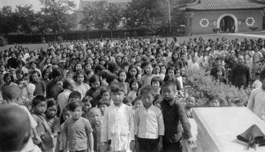home | metro silicon valley index | movies | current reviews | film review

COLLATERAL DAMAGE: The children of Nanking had nowhere to turn in 1937.
Shame
The documentary 'Nanking' shows how a handful of people tried to stop the horror of war
By Richard von Busack
IRIS CHANG got there first, and local filmmaker Rhawn Joseph followed closely afterward with a homemade film called Rape of Nanking (www.brainmind.com). Still, the new docudrama/documentary Nanking, by Bill Guttentag and Dan Sturman, has to stand as the ultimate account of a subject no one seems to want to remember. Seventy years ago this winter, the Chinese city of Nanking was subjected to one of most barbaric sieges in world history. Even with the elaborate testimony in Nanking, it's hard to conceive of the scope of the wanton slaughter by bored, keyed-up soldiers with time on their hands. They were just following orders: The Imperial Japanese Army's game plan was "The Three Alls: Kill All, Loot All, Burn All." After a brutal bombardment, the troops arrived. Under the pretext of finding deserting Chinese soldiers, they began a reign of terror. Women from 10 to 60 were hauled out to slake the lust of the soldiers; torture and mass murder of civilians and unarmed prisoners continued throughout the freezing weather. In the film, Chinese eyewitnesses testify to the killing of their mothers, brothers and sisters. Elderly Japanese soldiers and sailors describe what they were ordered to do to POWs. Incredibly, one old Japanese vet in a sleeveless T-shirt still chuckles at the thought of the raping he carried out—how it was better to help yourself to the married women, because they knew how to cooperate.Nanking tries to Schindlerize this tremendous agony by focusing on the 22 Europeans and Americans who bravely tried to stop the bleeding. In a soundstage, several actors emote the diaries and communiqués of the Westerners. A missionary named George Fitch (John Getz) carried reels of film sewn into the lining of his coat through the Japanese lines, risking his life to alert the world. The survivors call a couple of these heroes "buddhas of compassion." One of these Christian buddhas is enacted by Mariel Hemingway; she reads the letters of Minnie Vautrin, who was the head of a woman's college who stayed to protect her students. "Men are not asked to leave their ships in danger," Vautrin commented.
These people had great faith in the cross and the flag; one John Rabe, well acted by Jürgen Prochnow, was a German businessman who used the swastika to protect his Chinese. For his selflessness, Rabe was harassed by the Imperial Army and the Gestapo—and the Red Army by the time the war was over. Japanese unwillingness to revisit this part of its past is seen at the Yasukuni Shrine, where 14 Class-A war criminals are honored; we watch visitors crying their banzais and blatting their out-of-tune bugles. Still, we must not understand Nanking as one specific act of national mania but as conduct natural to one species of humanity's enemies—moronicus militarius, a pest endemic from Abu Ghraib to Darfur. Nanking quotes Miner Searle Bates, one of the individuals who stood up to military-organized cowardice: "Neither by national guns nor national Gods will mankind be saved."
![]() NANKING (R; 88 min.), a documentary by Bill Guttentag and Dan Sturman, opens Jan. 18 at Camera 12 in San Jose.
NANKING (R; 88 min.), a documentary by Bill Guttentag and Dan Sturman, opens Jan. 18 at Camera 12 in San Jose.
Send a letter to the editor about this story.
|
|
|
|
|
|